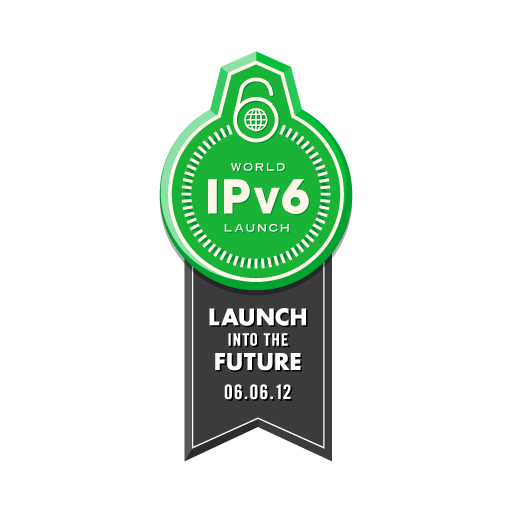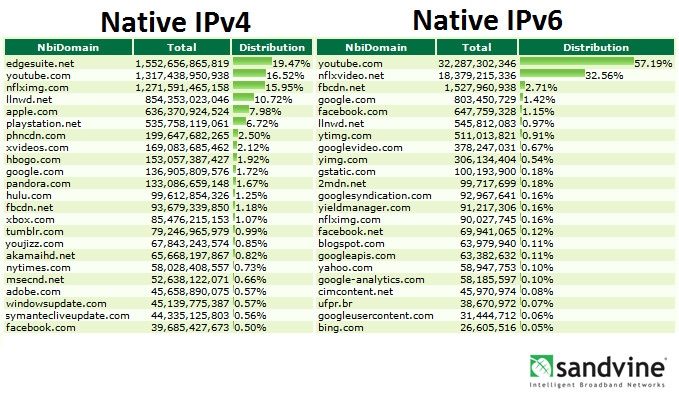 One week ago today (6 June 2012), the Internet Society (ISOC) led the charge on a voluntary initiative called World IPv6 Launch. Participating in this event were: five home router vendors, 77 Internet Service Providers, and 3,013 websites. By signing up as a website or ISP, you were committing to enabling IPv6 on your network or website on 6 June 2012; and then never disabling it. So this was basically the long awaited flag day for IPv6.
One week ago today (6 June 2012), the Internet Society (ISOC) led the charge on a voluntary initiative called World IPv6 Launch. Participating in this event were: five home router vendors, 77 Internet Service Providers, and 3,013 websites. By signing up as a website or ISP, you were committing to enabling IPv6 on your network or website on 6 June 2012; and then never disabling it. So this was basically the long awaited flag day for IPv6.
This is a big deal. The top 6 sites on the entire Internet enabled IPv6 last week. This means Google, Facebook, Microsoft, Yahoo and Wikipedia all felt that having IPv6 content available now is important for their bottom line. This is history folks, this has never happened to IPv6.
The Technical Breakdowns and Takeaways
This is all fine and dandy, but what have we seen? How has this affected Internet traffic in general? The answer is plenty – relatively speaking. TechTarget (taking in statistics from Geoff Huston and others) has a great graphic showing the state of IPv6 on the Internet for just the last 3 years. Basically, it’s quadrupled (see below).
Here’s some of the technical specifics and our wrap up one week into IPv6 Launch:
- Google noted a 75% increase in IPv6 web traffic – Eric Kline
- You can go to the “measurements” area of ISOC’s World IPv6 Launch site and see real-time statistics. Each of the 3,018 websites are polled for performance and functionality tests: http://www.worldipv6launch.org/measurements/
- Only 3% of those 3,018 websites (as of 12 June) have Path MTU problems. This is a 100% improvement from last year’s World IPv6 Day where 6% had IPv6 Path MTU Problems. A more notable example this year was F5 for F5.com and Sprint (which seems to still be having a Path MTU Discovery problem). For F5 (as shown by the PCAP below), the MTU in which 2001:980:5354:3:fa1e:dfff:fed8:8748 tries to reach F5.com (at 2001:19b8:101::f5f5:1d) is 730 bytes (well below the minimum maximum outlined in RFC 2460 of 1,280 bytes). F5.com returns a “packet too big message” telling it to reset to 712. So this was obviously an F5 problem from yesterday that seems to have been corrected – as shown by the tracepath6 I did a few minutes ago. All in all, very minor and very fixable.
laptop:~$ tracepath6 f5.com
1?: [LOCALHOST] 0.043ms pmtu 1480
1: 2001:470:X:X:X:X:X 23.912ms
1: 2001:470:X:X:X:X:X 23.928ms
2: XXXXX.tunnel.tserv13.ash1.ipv6.he.net 48.387ms
3: gige-g4-12.core1.ash1.he.net 54.084ms
4: dcp-brdr-04-xe-0-2-0.qwest.com 46.965ms asymm 5
5: 2001:428::205:171:203:161 129.568ms asymm 11
6: 2001:428:b202:10:0:1:0:2 128.230ms asymm 10
7: 2001:19b8:0:2::2 128.298ms asymm 12
8: 2001:19b8:101:2::f5f5:1d 128.846ms reached
Resume: pmtu 1480 hops 8 back 52
- Google is right around 1% of traffic over IPv6 (real time graph).
- Sandvine has a great graph showing the biggest hitters and their IPv6 traffic percentages – YouTube and Netflix seem to have the largest saturation with whopping 57% and 33% respectively:

- Finally, Akamai, one of the largest Content Distribution Network (CDN) providers has a real-time graph showing all of their IPv6 hits. As of 12 June, they were hovering around 75,000 hits per second.



